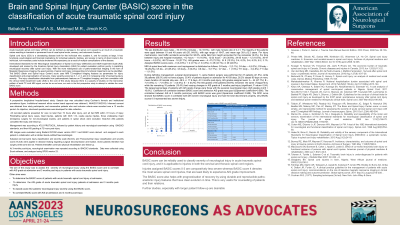Brain and Spinal Injury Center score in classification of acute traumatic spinal cord injury.
Brain and Spinal Injury Center Score in Classification of Acute Traumatic Spinal Cord Injury
Friday, April 21, 2023


Temitope Babalola, MBBS, FMCS (he/him/his)
Board-eligible Neurosurgeon
National Hospital, Abuja
Abuja, NG
ePoster Presenter(s)
Introduction: Acute traumatic spinal cord injury (ATSCI) causes serious morbidity in survivors.
ASIA impairment scale (AIS) classifies injury severity, with limited sensitivity and specificity. BASIC score uses axial MRI T2 signal changes to classify ATSCI. We sought to prospectively validate the BASIC score.
Methods: IRB approval obtained (NHA/EC/100/2019).
A prospective hospital-based study over 1 year. Patient resuscitation followed ATLS protocol. Neurological evaluation followed the ASIA standards ( ISNCSCI); status at 72 hours post-injury was documented. 1.5 T MRI was done within 72 hours of injury and images analysis led by a blinded board- certified neuroradiologist. Patients' BASIC scores were recorded. Neurological status was re- evaluated 3 months post-injury.
Results: 65 patients met the inclusion criteria. Mean age: 39.1+/- 12.3 years. Cervical ATSCI :n=60; (92.3%), thoracic ATSCI: n=5; (7.7%). AIS A: 72.3% , B: 12.3%; C :6.2%; D: 6.2%; E: 3.1%. BASIC score 4 =44.6%; 3= 43.1%; 2= 4.6%; 1= 3.1%; 0= 4.6%.
AIS grades 3months post-injury: A- 67.7%; B- 10.8%; C- 10.8%; D- 4.6%; E- 6.2%.
AIS improved at 3 months post-injury in 10 (15.4%): From A to B (4.6%), B to C (6.2%), C to D (1.5%), D to E (3.1%). (p-value = 0.040, Kappa = 0.68).
84.6% had no change.
BASIC score correlated with admission AIS grade (Spearman coefficient = 0.586).
BASIC score correlated with AIS grade 3 months post-injury (Spearman coefficient = 0.589). Positive predictive value for AIS grade A = 89.7%. Specificity for AIS grades B to E was 83.2%).
ROC Area under the curve (AUC) was 79.3% corresponding to a BASIC score above 3.
Conclusion : BASIC score is useful in classifying ATSCI severity, and is applicable to both cervical and thoracic ATSCI.
More research with larger sample size and a longer duration of observation may show the utility of this novel scoring system for classification of ATSCI.
ASIA impairment scale (AIS) classifies injury severity, with limited sensitivity and specificity. BASIC score uses axial MRI T2 signal changes to classify ATSCI. We sought to prospectively validate the BASIC score.
Methods: IRB approval obtained (NHA/EC/100/2019).
A prospective hospital-based study over 1 year. Patient resuscitation followed ATLS protocol. Neurological evaluation followed the ASIA standards ( ISNCSCI); status at 72 hours post-injury was documented. 1.5 T MRI was done within 72 hours of injury and images analysis led by a blinded board- certified neuroradiologist. Patients' BASIC scores were recorded. Neurological status was re- evaluated 3 months post-injury.
Results: 65 patients met the inclusion criteria. Mean age: 39.1+/- 12.3 years. Cervical ATSCI :n=60; (92.3%), thoracic ATSCI: n=5; (7.7%). AIS A: 72.3% , B: 12.3%; C :6.2%; D: 6.2%; E: 3.1%. BASIC score 4 =44.6%; 3= 43.1%; 2= 4.6%; 1= 3.1%; 0= 4.6%.
AIS grades 3months post-injury: A- 67.7%; B- 10.8%; C- 10.8%; D- 4.6%; E- 6.2%.
AIS improved at 3 months post-injury in 10 (15.4%): From A to B (4.6%), B to C (6.2%), C to D (1.5%), D to E (3.1%). (p-value = 0.040, Kappa = 0.68).
84.6% had no change.
BASIC score correlated with admission AIS grade (Spearman coefficient = 0.586).
BASIC score correlated with AIS grade 3 months post-injury (Spearman coefficient = 0.589). Positive predictive value for AIS grade A = 89.7%. Specificity for AIS grades B to E was 83.2%).
ROC Area under the curve (AUC) was 79.3% corresponding to a BASIC score above 3.
Conclusion : BASIC score is useful in classifying ATSCI severity, and is applicable to both cervical and thoracic ATSCI.
More research with larger sample size and a longer duration of observation may show the utility of this novel scoring system for classification of ATSCI.
